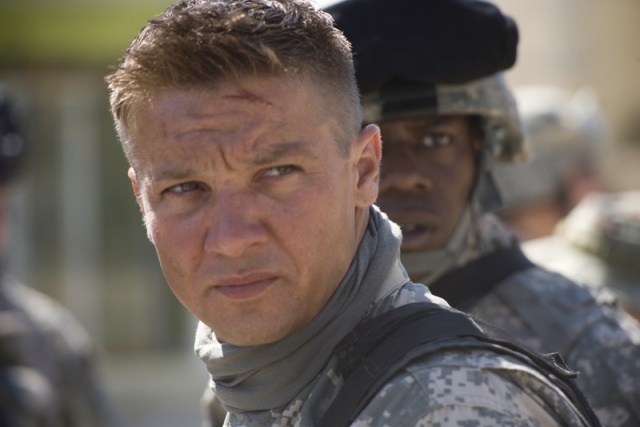 Jeremy Renner
Jeremy Renner
Film Friday
I taught Kathryn Bigelow’s Hurt Locker in my film genre course earlier this week. The film both impressed and depressed me.
I have been teaching action adventure films and how our culture uses this genre to sort through male identity issues. Drawing on a very useful book by Susan Jeffords, Hard Bodies: Hollywood Masculinity in the Reagan Era, I talked to my students about how the “hard-bodied hero” came into vogue in the 1980s, only to be replaced by a kinder, gentler hero in the 1990’s (“kinder, gentler” is George H.W. Bush’s phrase). If Stallone, Schwarzenegger, and Chuck Norris ruled in the 1980’s, Tom Hanks, Steve Martin, and a kinder gentler Schwarzenegger ruled in the 1990’s.
Much of the enthusiasm for hard bodies, Jeffords points out, was in response to the crisis over the Vietnam debacle, the Iranian hostage crisis, and feminism. For a while American men felt they had to be rock hard and then, when being hard took a psychological toll, felt they had to reconnect with their feelings again. Therefore, we had Reagan-bo in the 1980’s and “I feel your pain” Clinton in the 1990’s. (George “thousand points of light” Bush serves as the transition.)
If Jeffords is right, I asked my students, what does Hurt Locker tell us about male identity in the age of Bush II and Obama?
The movie is about a bomb squad in Iraq and a soldier who is addicted to the adrenaline rush he gets from defusing explosives. The rush is so great, in fact, that it is the only thing he loves. He finds life with his wife and child so unsatisfying that no sooner does he return home than he re-enlists. The movie is visually chaotic, with low key lighting, few establishing shots, tilted camera angles, and rapid fire editing. The viewer never feels in control of the visual plane.
What depressed me about the movie is its cynicism about any greater purpose. To be sure, cynicism is inherent in the war movie, especially since the Vietnam War movies. But Hurt Locker seems more pessimistic than most. War is just a matter of survival, and even the satisfaction of bonding with buddies is transitory. There is even less comradeship here than in Vietnam War films.
In fact, one of the most haunting scenes involves the hero going back to his room after a drinking bout with his fellow soldiers, sitting down on his bed, and donning his protective blast helmet. This is where he feels most at home.
The class that I am teaching is made up of seniors, and I couldn’t help looking at the film through their vantage point, especially that of my male students. Is this how they see the world, as a fragmented realm where one just tries to survive and has brief social encounters with others? I know this is what drew such students to Fight Club and Memento in the late 1990’s, and it bothered me that I wasn’t seeing any Obama optimism here. Instead, we were watching a bleak drama that struck my students as “real.”
We discussed other action adventure films from the 21st century. For a while, the “reluctant warrior” seemed to dominate (my students cited Pirates of the Caribbean and Rundown). This is perhaps to be expected following 9/11 and our entry into two wars.
I wondered whether a movie like Clint Eastwood’s Grand Torino (2008) might be pointing in a different, softer direction. After all, with its sensitivity towards immigrants and its doubts about vigilante violence (in that way it seems a repudiation of Eastwood’s 1970’s Dirty Harry movies), it reflects some of Obama’s vision. (Obama wasn’t elected yet but movies often anticipate history.)
Now having seen Hurt Locker, however, I’m not sure. Maybe the hopes that Obama raised have been thrown into doubt, whether by the recession, by Tea Party rage, or by Republican intransigence. Is that why, for my students, an unsettled film about non-stop expolsions (or threatened explosions) seems more true to life? I’ll be monitoring patterns and let you know what I discover.


One Trackback
[…] post: Hurt Locker and Confused Young Men By admin | category: young male | tags: campaign-within, compelling-advertising, […]